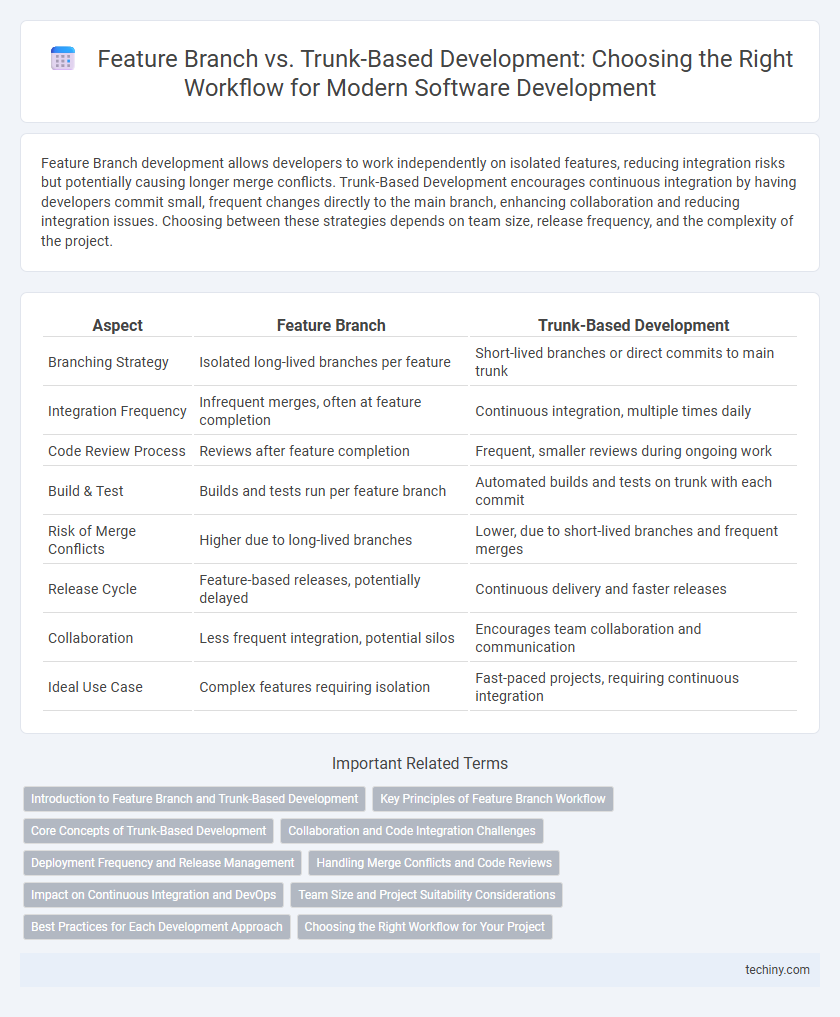Feature Branch development allows developers to work independently on isolated features, reducing integration risks but potentially causing longer merge conflicts. Trunk-Based Development encourages continuous integration by having developers commit small, frequent changes directly to the main branch, enhancing collaboration and reducing integration issues. Choosing between these strategies depends on team size, release frequency, and the complexity of the project.
Table of Comparison
| Aspect | Feature Branch | Trunk-Based Development |
|---|---|---|
| Branching Strategy | Isolated long-lived branches per feature | Short-lived branches or direct commits to main trunk |
| Integration Frequency | Infrequent merges, often at feature completion | Continuous integration, multiple times daily |
| Code Review Process | Reviews after feature completion | Frequent, smaller reviews during ongoing work |
| Build & Test | Builds and tests run per feature branch | Automated builds and tests on trunk with each commit |
| Risk of Merge Conflicts | Higher due to long-lived branches | Lower, due to short-lived branches and frequent merges |
| Release Cycle | Feature-based releases, potentially delayed | Continuous delivery and faster releases |
| Collaboration | Less frequent integration, potential silos | Encourages team collaboration and communication |
| Ideal Use Case | Complex features requiring isolation | Fast-paced projects, requiring continuous integration |
Introduction to Feature Branch and Trunk-Based Development
Feature Branch development involves creating separate branches for each new feature, allowing isolated changes and parallel work without impacting the main codebase. Trunk-Based Development emphasizes frequent integration into a single shared branch, minimizing merge conflicts and promoting continuous integration and delivery. Both strategies aim to streamline collaboration and improve code stability, with feature branches offering granularity and trunk-based supporting rapid deployment cycles.
Key Principles of Feature Branch Workflow
Feature Branch Workflow centers on isolating development work in separate branches, enabling parallel feature development without disrupting the main codebase. It emphasizes frequent integration of smaller, manageable changes through pull requests, ensuring code reviews and automated testing validate quality before merging. This approach enhances collaboration, reduces integration conflicts, and supports traceability by clearly linking changes to specific features.
Core Concepts of Trunk-Based Development
Trunk-Based Development centers on a single shared branch, known as the trunk or mainline, where developers integrate small, frequent code changes to ensure continuous integration. This core concept minimizes merge conflicts and simplifies code reviews by maintaining a stable and up-to-date codebase. Emphasizing short-lived feature toggles and automated testing supports rapid delivery and high code quality in collaborative environments.
Collaboration and Code Integration Challenges
Feature Branch development often leads to longer-lived branches, causing frequent merge conflicts and hindering continuous integration, which impacts team collaboration and code stability. Trunk-Based Development promotes smaller, incremental code changes merged directly into the main branch, enabling faster feedback, reducing integration challenges, and enhancing cross-functional team collaboration. Effective communication and automated testing pipelines are essential to mitigate code integration challenges in both approaches, ensuring higher code quality and smoother collaboration.
Deployment Frequency and Release Management
Feature Branch development often results in lower deployment frequency due to isolated code changes requiring extensive integration and testing before merging. Trunk-Based Development increases deployment frequency by encouraging small, incremental commits directly to the main branch, simplifying release management and enabling continuous integration. This approach reduces merge conflicts and accelerates delivery cycles, making it ideal for rapid and frequent releases.
Handling Merge Conflicts and Code Reviews
Feature Branch development isolates code changes in separate branches, allowing focused code reviews and reducing immediate conflicts but often leading to complex merge conflicts during integration. Trunk-Based Development emphasizes frequent commits to a single mainline, enabling continuous integration and simpler, smaller merge conflicts, while facilitating rapid, iterative code reviews. Handling merge conflicts is streamlined in Trunk-Based Development due to reduced divergence, whereas Feature Branches require careful conflict resolution strategies before merging.
Impact on Continuous Integration and DevOps
Feature Branch development can slow down Continuous Integration by introducing integration delays and merge conflicts, which hinder rapid feedback loops essential for DevOps efficiency. In contrast, Trunk-Based Development promotes smaller, frequent commits directly to the mainline, enabling faster integration, automated testing, and streamlined deployment pipelines. This approach enhances collaboration among development, testing, and operations teams, accelerating delivery cycles and improving overall software quality.
Team Size and Project Suitability Considerations
Feature Branch development suits larger teams handling complex projects, enabling isolated work and minimizing integration conflicts. Trunk-Based Development fits smaller teams or fast-paced projects by promoting continuous integration and reducing merge issues. Choosing between them depends on team size, project complexity, and deployment frequency requirements.
Best Practices for Each Development Approach
Feature Branch development emphasizes isolating work in separate branches to enhance code review quality and reduce integration risks through frequent merges. Trunk-Based Development calls for developers to integrate small, incremental changes directly into the mainline, ensuring continuous integration and reducing merge conflicts. Best practices include maintaining short-lived feature branches, automating testing pipelines, and using feature toggles in Trunk-Based Development to balance rapid deployment with stability.
Choosing the Right Workflow for Your Project
Choosing the right workflow between Feature Branch and Trunk-Based Development depends on your project's complexity, team size, and release frequency. Feature Branch workflows suit larger teams requiring isolated development and thorough code reviews, while Trunk-Based Development enables faster integrations and continuous delivery through frequent commits to the main branch. Evaluating your project's need for stability versus rapid iteration helps determine the optimal strategy for code collaboration and deployment.
Feature Branch vs Trunk-Based Development Infographic

 techiny.com
techiny.com